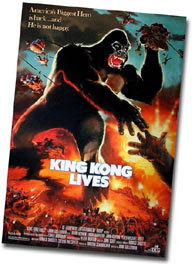
This is a column written on the basis of
a dare, a personal challenge issued to me, keeper of the Kong
Files. "If your mission is to write about all things Kong,"
wrote the anonymous petitioner, "let's see you do a piece of
King Kong Lives. An interesting piece."
I swallowed hard at the mention of what has to be one of
the worst Kong-related films ever made (foreign or domestic)
but resolved to come through in the clutch.
Here then, is Part One of a two part (!) look at Dino DeLaurentiis's
1986 sequel to his 1976 Kong remake -- undertaken with the condition
that I am free to engage in self-indulgent, self-serving digressions.
In return for the reader's indulgence I will resolve to get
both parts posted in under a week.
So we begin. True Story. Honest.
It was a couple years ago and I was visiting the in-laws
on a long weekend in Minnesota. Since I was deep into working
on what was then called "Skull Island", the Joe DeVito book
that eventually became "Kong, King of Skull Island", I had to
spend much of the weekend hunched over a laptop.
I was, frankly, nearly burned out. I'd pitched "Skull Island"
all over the place. Joe had been working on art and an elaborate,
detailed back story for years before I'd met him, coming tantalizingly
close to publication on a couple of occasions. Now we were working
together to get the thing off the ground once and for all, suffering
the usual diet of rejections and dismissals along the way. Unfortunately,
we were very seldom the beneficiaries of a merciful "quick no."
Instead, editors at publishing houses that shall remain nameless
would string us along for weeks and months - asking for additional
character summaries, sample chapters, story treatments, another
synopsis, etc. all along the way - before finally passing on the
project. This was before the general public knew that Peter
Jackson's remake was on the horizon: "People don't know who
King Kong is. Thanks anyway." 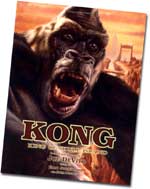 |
It was getting to be absolutely grueling. If it was tough
for me, you can imagine how hard it was for Joe, who had done
an incredible amount of work on the story and art -- years worth -
- before
I came into the picture. The framework he already had in place
was impressive, but, as any writer will tell you, nailing down
details of character and plot into a cohesive narrative thread
is very difficult. "Skull Island" was designed to be a sequel
and prequel to King Kong (as manifested in the 1933 film)
- that's
a lot of territory to cover. Joe had worked out pages and pages
of explanatory back story on the Skull Island culture, chock
full of mass exoduses, forgotten technologies, subterranean
passages, evolving flora and fauna, warring philosophies, religious
undercurrents, ancient citadels, political intrigue. How do
you get all that across while telling a good adventure story?
(Ask Brad Strickland, as he was able to do it very well in "Kong:
King of Skull Island".)
I went at the "Skull Island" tale from quite a different
angle than Joe and Brad eventually did. In many of my plots
- I
did countless variations that still live on my Mac - the four
central characters that travel back to Skull Island in 1958
are Vincent Denham (paleontologist son of showman Carl, and
thus subject to ridicule by his academic peers), Susan Driscoll
(daughter of the deceased Jack and Ann Driscoll, she is able
to secure a boat for a journey to the island and has found an
old pirate's logbook among her parents' possessions, and therefore
comes along for the trip; think Kate Hudson), a none-too-likable
"Kong conspiracy theorist" named Frank Overton (who seeks to
prove that Skull Island actually exists), and William "Stacks"
Stackner, an older, rugged and well-traveled "field man" who
works with Denham at the Museum of Natural History in New York
(sort of a proto-Indiana Jones who serves as Vincent's temporary
father figure). Since my version stays in the vault I can spill
these beans: the event that brings the protagonists together
is Ann Driscoll's funeral; we learn that Jack and Ann's flight
away from Kong's lair was aided by the accidental discovery
of underground passages with pictograph-scrawled walls (one
of many secrets kept from Denham by the two lovers); and it
becomes clear that Captain Engelhorn avenged his decimated crew,
marooning mortally injured Carl Denham on Skull Island when
the regretful showman sails back in an attempt to clear his
conscious by returning Kong's body (watch Englehorn's interactions
with Denham in the '33 film and tell me he doesn't have a bad
taste in his mouth!) Thus, Vincent discovers on Skull Island
both Kong's body (eerily partially preserved within the still-sealed
hold of the beached Venture; imagine popping the hatch and shining
a flashlight on that) and his father's grave; two betrayed,
toppled giants who died far away from home. And, naturally,
"Stacks" meets his demise in noble fashion late in the story.
|
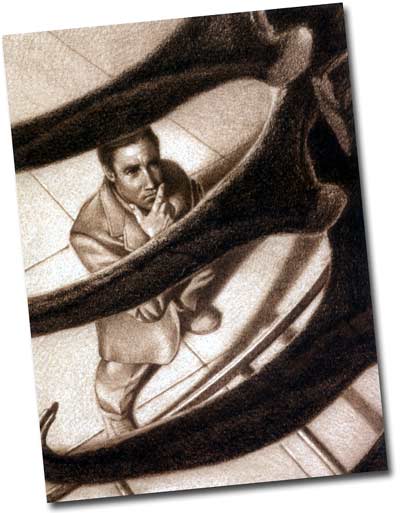
|
Illustration
by Joe DeVito,
from "Kong: King of Skull
Island |
One of my favorite little exchanges is between Vincent Denham,
halfconscious and recuperating from injuries suffered while
coming ashore on Skull Island, and Storyteller, the very old,
very mystic islander who is caring for him. At one point Joe
proposed that Vincent should be a Jesuit seminarian (though
still studying paleontology) experiencing a crisis of faith.
This is from one of my story treatments:
"You called for your father, Vincent Denham. You also cried
out the name of Kong," she says. She is a native of the island
and tells him to call her Storyteller; she is the living collective
memory of the people of Skull Island.
Vincent sees that he is now wearing his rosary around his
neck; Storyteller has evidently placed it there. He sees that
Storyteller wears a very ornate necklace of her own that is
unmistakably the one he saw sketched in the pirate logbook.
"Does your amulet give you comfort? Who is the suffering
man depicted?" asks the Storyteller.
Vincent speaks haltingly. "He is Christ, the living sacrifice.
He is the focus of our worship."
"You kill your deity. You kill our deity. For the luvva Mike,"
she snorts derisively.
Vincent flinches and repeats. "For the luvva Mike?" He recovers
himself. "What of your necklace…?" he asks.
"For the luvva Mike, I am the living sacrifice as well." Or, more specifically, "the sacrifice that lived"; of course,
the ornate necklace in question is reserved for female offerings
to Kong, and we later learn that Storyteller picked up the snappy
thirties-era slang from Carl Denham himself.
Another digression: I planned to propose that Joe create
two double-gatefold paintings of the Skull Island wall -- one circa
1930 and the other circa Skull Island's much-earlier "golden
age" -- that appear in different sections of the book. You could
"open" the gates from the center to reveal a stunning four panels/pages-wide
"vista view" (like Merian Cooper's Cinerama!) of the native
village as it looked in both eras. During the older "golden
era," you see the many sophisticated dwellings and utility structures
Joe had meticulously thought through and designed, and even
ingenious use of a developed shoreline; the scene tells you
volumes about how the people of Skull Island lived without having
to resort to a word of prose. The 1930-era view of the exact
same vista depicts the "backslide" of the culture and its state
when Denham landed there. The wall itself is crudely patched
and maintained; in the village you see where formerly handsome
colonnades and ingenious water pumps, for instance, are now
mere shadows of their earlier form and are crudely repurposed;
the shoreline has eroded, shrinking the usable space; the jungle
is slowly "swallowing up" everything with roots, vines and creepers;
and depictions of Kong replace those of the earlier deity "Gaw."
It's the kind of storytelling device that only Joe DeVito could
have pulled off because his years-in-the-making vision of Skull
Island and its history is developed to the extent that he'd
leave no stone unturned. (I also thought we could go really
crazy and do a third double-gatefold treatment of the wall and
village circa 1958: busted gate crudely repaired; village still
bearing scars of Kong's rampage; strange alterations to the
various Kong totems reflecting the natives' disorientation after
his capture, etc. Cost be damned!)
So, anyway, on this particular weekend I was, as they say,
blocked. Mental constipation; nothing was coming. All the typical
fears began burrowing into my psyche. I was beginning to believe
the naysayers: maybe no one cares about King Kong as a character.
I had apprehensions regarding my family's fiscal health: this
was turning into quite an expensive project and I was neglecting
workaday paying gigs to keep the "Skull Island" plates spinning.
And, of course, I didn't want to drop the ball, creatively speaking,
and have Joe and I become responsible for something that didn't
live up to all that is good and classic about King Kong.
I had visions, specifically, of missteps like DeLaurentiis's
King Kong and King Kong Lives.
So, as I often do when thus stymied, I took my little portable
office to the local Border's book store and haunted the "Writers
and Writing" aisle. As a writer with no "co-workers" with whom
to commiserate, I often find it soothing to read about other
people struggling to pin their ideas to paper, or get no-nonsense,
often outrageous advice from gritty veterans who seem to live
on different planets. (To paraphrase one of my favorite such
passages about "the writer's life": "I arise at four a.m. and
get to my desk in my third-story study, wheat toast and tea
in hand, by 4:10. I begin writing immediately, breaking at seven
a.m. to breakfast with my family and read the day's paper before
returning to work at eight with more toast and tea. At ten I
begin to edit the morning's work, usually three pages or so.
At noon I meet my son for lunch consisting of soup and a bagel
at a diner we like downtown. Then, it's off to do my errands….".
How genteel - sounds like some sort of writer's fairyland.)
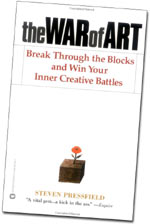 |
A slim volume called "The War of Art" by Steven Pressfield called out to me. The subtitle was
especially effective: "Break Through the Blocks and Win Your
Inner Creative Battles." I grabbed a seat and dug in. The book
consists of single-page meditations on various aspects of the
creative life, concentrating principally on recognizing and
overcoming what the author calls "Resistance." Resistance is
anything that stands between you and consummation of your creative
or constructive goals. It can manifest itself as fear, procrastination,
rationalization, loneliness, self-medication, self-doubt, lack
of discipline - the list is dreadfully long, and these factors
are arrayed against you when you face that empty computer screen
or blank canvas. Resistance can reside in overt distractions;
right now, for instance, there's a guy firing nails into my
office window frame and his boombox is blaring that overproduced
modern country music that I find especially noxious. At the
same time, a less obvious but equally deadly form of Resistance
is threatening my concentration as I drift to the issue of just
exactly how I'll manage to pay for the array of overdue home
repairs we're having done this week.
I was completely hooked after three minutes; this Pressfield
guy knew what he was talking about -- a genius. Nearly every page
of this great book is quotable, but one particularly insightful
passage hit me where I live:
RESISTANCE AND LOVE
Resistance is directly proportional to love. If you're feeling
massive Resistance, the good news is, it means there's tremendous
love there too. If you didn't love the project that is terrifying
you, you wouldn't feel anything. The opposite of love isn't
hate; it's indifference.
The more resistance you experience, the more important the
unmanifested art/project/enterprise is to you - and the more gratification
you will feel when you finally do it. So I'm working on a Kong project -- if that ain't love, what
is? "The War of Art" had me hook, line and sinker. I found a
comfortable seat and dove in.
Then things got weird. This is from page 71:
The first professional writing job I ever had, after seventeen
years of trying, was on a movie called King Kong Lives. Say what? WHAT?!?! I think I may have said that
- or made some
kind of noise -- out loud; I remember people turning to look at
me. Mouth agape, I read on:
I and my partner-at-the-time, Ron Shusett (a brilliant writer
and producer who also did Alien and Total Recall) hammered out
the screenplay for Dino DeLaurentiis. Ah -- a tale of artists betrayed by directors and producers.
They probably wrote something great and saw it bastardized onscreen.
Wrong:
We loved it; we were sure we had a hit. Even after we'd seen
the finished film, we were certain it was a blockbuster. Even after they'd seen the finished film!
We invited everyone we knew to the premiere, even rented
out the joint next door for a post-triumph blowout. Get there
early, we warned our friends, the place'll be mobbed.
Nobody showed. There was only one guy in the line beside
our guests and he was muttering something about spare change.
In the theater, our friends endured the movie in mute stupefaction.
When the lights came up, they fled like cockroaches into the
night.
Next day came the review in Variety: "…
Ronald Shusett and
Steven Pressfield; we hope these are not their real names, for
their parents sake." When the first week's grosses came in,
the flick barely registered. Still I clung to hope. Maybe it's
only tanking in urban areas, maybe it's playing better in the
suburbs. I motored to an Edge City multiplex. A youth manned
the popcorn booth. "How's King Kong Lives?" I asked. He flashed
thumbs down. "Miss it, man. It sucks." Astounding! What are the odds?
I should make something clear before continuing to excoriate
King Kong Lives: Mr. Pressfield recovered nicely from the debacle
and went on to write, among other things, "The Legend of Bagger
Vance" and an acclaimed series of historical novels set in ancient
Greece, the latest of which is "The Virtues of War: A Novel
of Alexander the Great.". For his part,
co-writer Ronald Shusett had co-written Alien before working
on King Kong Lives, and then went on to write Total Recall and
contribute the rest of the Alien series as well as other hugely
successful films.
This only makes the oddity that is King Kong Lives that much
more mystifying. If you've seen the movie you have to wonder
what the heck happened. It is bad, really appalling
- yet the
guys who wrote it are anything but hacks (having just started
Pressfield's "The Virtues of War: A Novel of Alexander the Great",
I can say without reservation that the guy is brilliant).
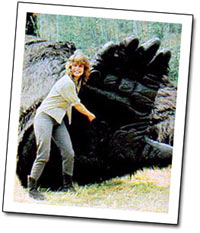
|
I re-watched King Kong Lives and my memory of its awfulness
was confirmed. Terrible. I'll save the specifics for Part Two,
but it seemed to me that many of the film's set pieces were
designed in service to the economic necessity of re-using props
from 1976; my theory was that the writers were given a list
of items that were available (giant head and shoulders of Kong,
huge mechanical hand, giant corpse, full size legs and feet,
etc) and needed to write scenes that utilized them (there's
a scene showing Kong buried to his shoulders, for instance,
tormented by hillbillies). Much of the action takes place in
wooded areas, eliminating the need for complex miniatures. Now
that I knew who one of the writers was (and located his website)
I could hear his recollection of what had to be a strange experience.
So I contacted him immediately.
Coming in Part Two: King Kong Lives.
(Writer John Michlig's online article KING KONG: LOST AND FOUND can be seen at http://www.skullisland.net/KongBoomer.html. He's currently working with filmmaker James Mansfield on a documentary entitled EIGHTH WONDER: THE AMAZING TRUE STORY OF CARL DENHAM AND THE BEAST-GOD OF SKULL ISLAND, the startling details of which he promises to share in the very near future.)
THE KONG FILES and contents are © 2004-2006 John Michlig and written for KongisKing.net, subsidary of The One Ring®, Inc.
|




